By Petra Beck, Senior Analyst at Infosource
I continue my tradition of providing my top 10 predictions for the Intelligent Information Processing (IDP) market at the beginning of the year. These are highlights of my much more comprehensive assessment of market dynamics that influence the development of the IDP market.
#1: GenAI's Dual Impact – Slowing Growth Before Driving New Opportunities
Generative AI (GenAI) is set to revolutionise the Intelligent Document Processing (IDP) market by transforming input ingestion and automating business processes. Following the initial hype and subsequent frustration in 2024, the market growth saw a temporary slowdown. This deceleration, with growth barely reaching double digits compared to the previous 15%, was due to high deployment costs, lower-than-expected ROI, rapid GenAI advancements, and regulatory uncertainties.
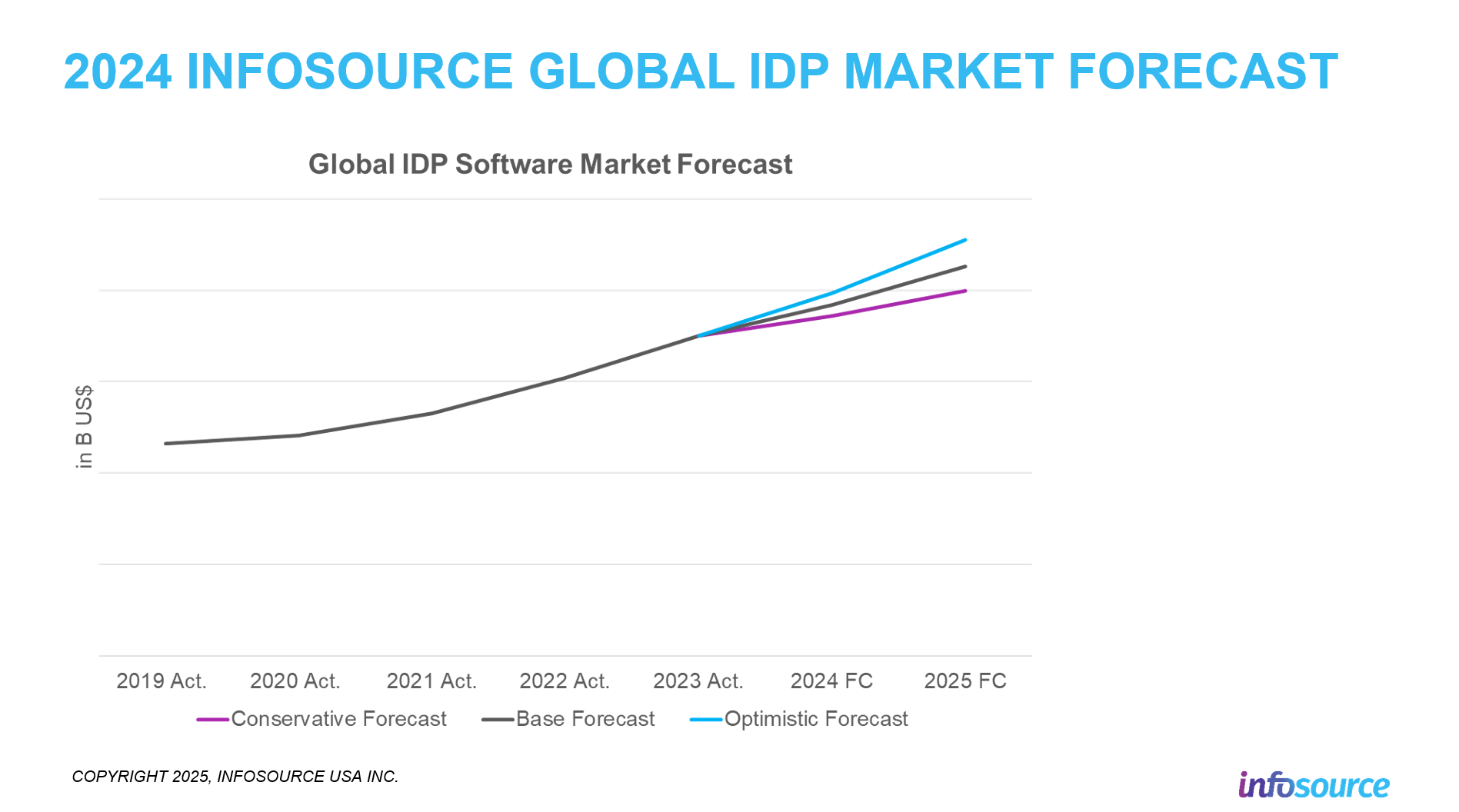
However, 2025 will see these challenges gradually turn into growth drivers:
- Proven ROI for GenAI-Infused IDP Solutions: As the year progresses, more use cases will demonstrate strong ROI. This will be driven by end customers carefully selecting and piloting key use cases for GenAI-enhanced IDP solutions, and vendors gaining expertise in deploying advanced GenAI technologies.
- Rapid Pace of GenAI Development: The fast development of specialised and customised language models (LMs) and Retrieval-Augmented Generation (RAG) capabilities will continue to push the boundaries for business process automation. IDP vendors will need to stay agile and innovative to keep up with these advancements.
- Increasing Regulatory Confidence: As AI-related regulations get finalised and their impact becomes clearer, end customers will start to feel more confident about deploying GenAI-based IDP solutions in their organisations.
While 2025 will still present challenges, there is light at the end of the tunnel. These factors will increasingly act as accelerators, positioning the IDP market for significant growth in the years to come.
I will start collecting inputs from all IDP vendors for my 2025 State of the IDP market assessment in March. In the meantime, I would like to invite you to read my blog post with highlights from my 2024 State of the Industry assessment:
State of the Global Intelligent Document Processing Market 2023/2024 – Info-source.com
#2 Retrieval Augmented Generation comes to IDP
One of the most promising advancements in the Intelligent Document Processing (IDP) market is the integration of Retrieval-Augmented Generation (RAG) into IDP solutions to enhance and supplement Large Language Models (LLMs). RAG can be used to replace or complement specialised language models.
For context, this is how I define RAG in the context of IDP: RAG is an advanced AI methodology that enhances the capabilities of large language models (LLMs) by integrating knowledge bases. This approach allows LLMs to generate more accurate and contextually relevant responses by retrieving and incorporating relevant information from internal and external sources.
The combination of retrieval-based and generation-based models ensures that the information extracted is both precise and contextually appropriate. RAG significantly enhances GenAI-infused IDP solutions by addressing concerns about the use of general language models in business transactions and their shortcomings:
- Confidentiality and Privacy Compliance: Chunking techniques allow only snippets of confidential documents to be shared with LLMs, addressing concerns related to sharing sensitive data. This ensures that sensitive information is protected while still leveraging the power of AI.
- Improved Contextual Understanding: RAG can retrieve domain-specific information from specialised internal and external databases. It enables a deeper comprehension of document context, leading to more meaningful and actionable data extraction. This improved contextual understanding is particularly beneficial for complex documents, ensuring higher accuracy and reliability.
- Up-to-date Information: While LLMs are typically trained on static datasets and may not have access to the most current information, RAG systems can connect to real-time data sources, such as internal databases or external APIs. This capability ensures that the responses are timely and relevant.
- Cost Efficiency: By leveraging RAG, organisations can avoid the high costs associated with retraining LLMs for domain-specific use cases. IDP plays a dual role here: it can be used to generate a knowledge base that RAG can access, and GenAI-powered IDP solutions can also leverage this cost benefit.
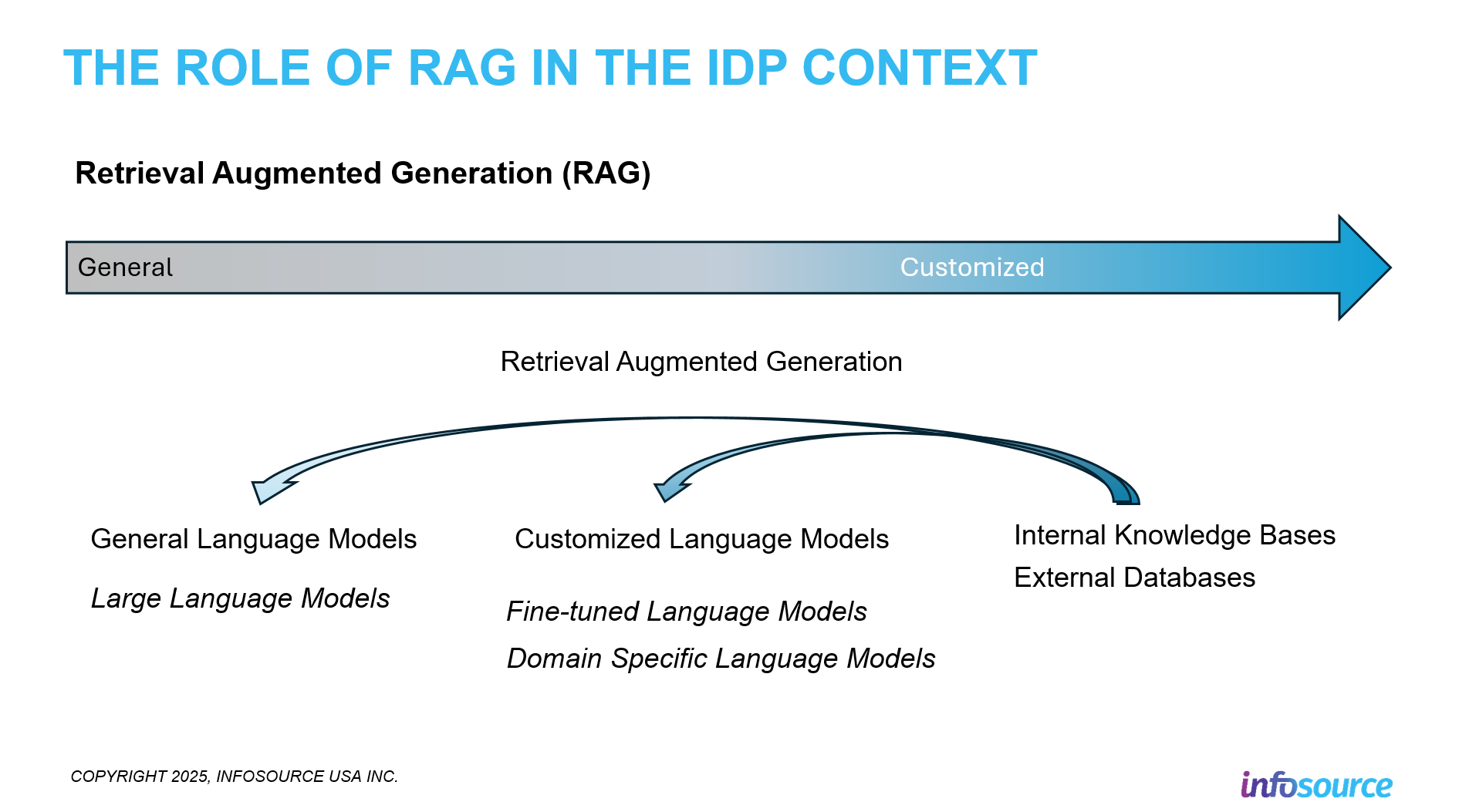
By leveraging the strengths of both IDP and RAG, organisations can create more intelligent and efficient systems that provide accurate, context-aware responses, streamline document processing workflows, and maintain high standards of data privacy and security.
#3: E-Invoicing Becomes Real: A Market Prediction for the IDP Industry
In recent years, the landscape of invoice processing has undergone a significant transformation. The advent of e-invoicing, driven by the need for increased tax compliance and the benefits of digital workflows, is reshaping how businesses handle their accounts payable (AP) and accounts receivable (AR) processes. E-invoice mandates require invoice data to be submitted following a defined standard to a government portal, which in most geographies also serves as a repository for the invoice data. There are distinct standards by country or a group of countries like the European Union, with some similarities of the standards. Peppol (Pan-European Public Procurement Online) is a standardised framework that is widely adopted across many countries, not just in Europe but also in regions like Asia-Pacific and North America.
- The rise of e-invoicing requirements continues in 2025: Governments worldwide are implementing and enforcing e-invoicing mandates for B2B business transactions to capture real-time transaction data, reduce tax evasion, and simplify the tax reporting process. Typically, e-invoicing mandates are rolled out in stages, starting with B2G (business-to-government) and expanding to B2B (business-to-business) sectors. The rollout progresses from voluntary to mandatory and from large to small businesses, with specific thresholds varying by country.
- The rollout of B2B e-invoicing mandates is at different stages across the globe but continues to progress. A couple of examples of new mandates or key milestones of rollout efforts in 2025 include:
- Australia will complete its rollout with the implementation of its third phase for the B2B sector in July 2025.
- German businesses need to be able to receive e-invoices for domestic B2B transactions starting from January 1, 2025.
- China has completed the national implementation of electronic digitalised invoices (Fully Digitalised E-Fapiao) on 1st December 2024.
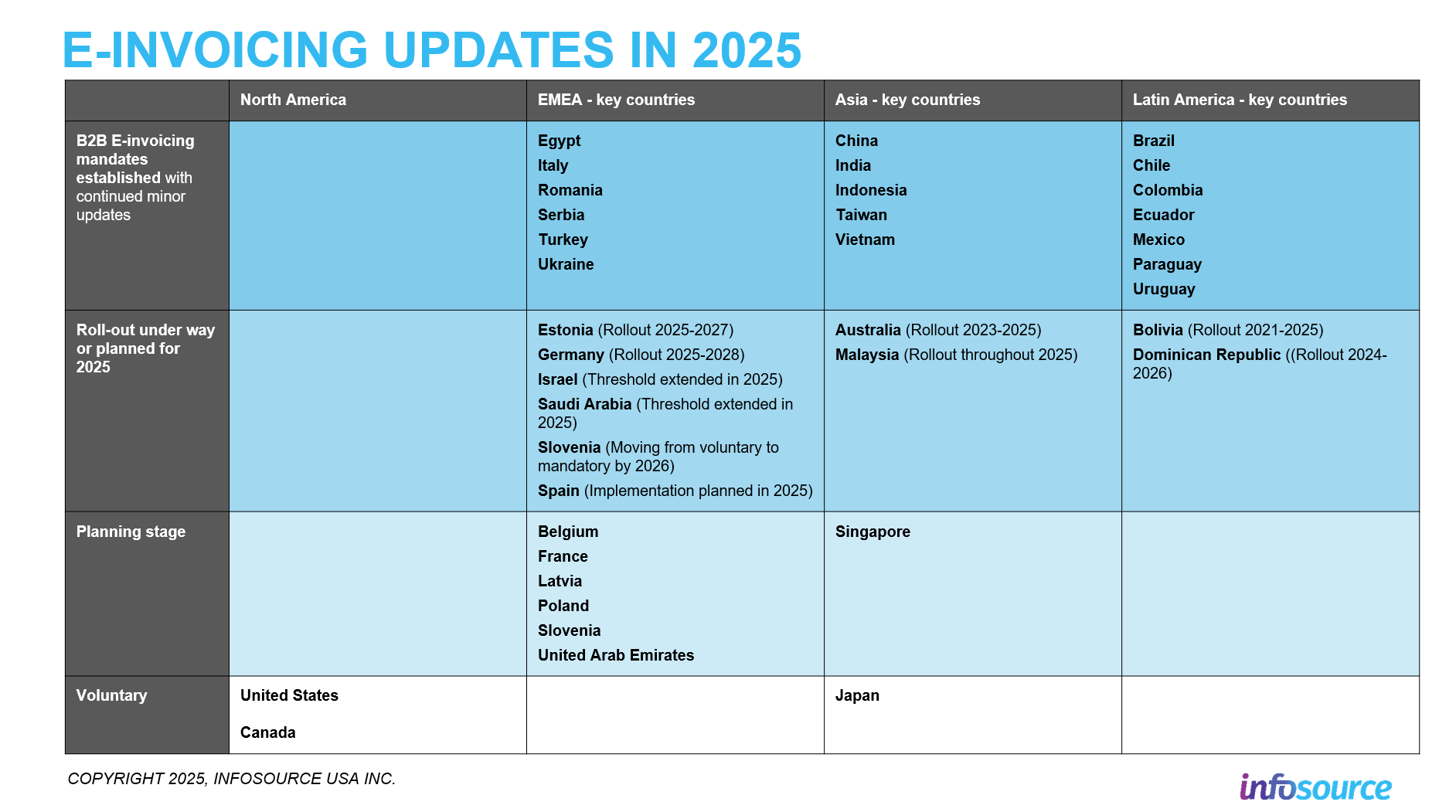
- Shift of Invoice Formats: During the step-by-step deployment of e-invoicing mandates, organisations require IDP solutions that support the rapidly shifting mix of invoice formats. These often consist of paper invoices, digital invoices, EDI formats, and e-invoicing formats.
- Change Management: The shift from a semi-manual handling of invoices to automated processing via a government platform requires major process changes and materially changes the requirements and work patterns in the accounting department.
- Future Impact on IDP Solutions: The shift towards e-invoicing will have a profound impact on IDP solutions. As e-invoices are structured and standardised, the need for classifying and extracting invoice data will diminish. However, this shift will not render IDP solutions obsolete. Instead, the focus will shift towards additional process steps that lead to the end-to-end automation of AP and AR processes.
#4: The Growing Importance and Feasibility of Multimodal Capabilities
In today’s business landscape, a significant portion of inputs still arrives as paper documents that need to be digitised and integrated into digital processes. While there has been a gradual shift from paper to digital inputs, the pandemic accelerated this transition, which continues to progress steadily.
However, the sources and types of business inputs vary significantly by use case and geography. Factors influencing this variation include the overall level of digitalisation in each country, driven by culture, government guidance, enterprise and sector digitalisation efforts, and regulations. Although this trend is universal across industries, there are notable differences between use cases, industries, and geographies.
In 2025, I predict this mix shift will accelerate for several reasons, each reinforcing the other:
- Increased Willingness to Meet Multi-Channel Communication Demands: Particularly in B2C transactions, driven by the pressure to meet heightened customer experience expectations.
- Accelerated Shift to Digital Inputs: As part of transformation initiatives or mandates like e-invoicing, as detailed in my previous prediction.
- Growing Multimodal Capabilities of Large Language Models (LLMs): These models support the ingestion of an increasingly diverse mix of multi-format inputs.
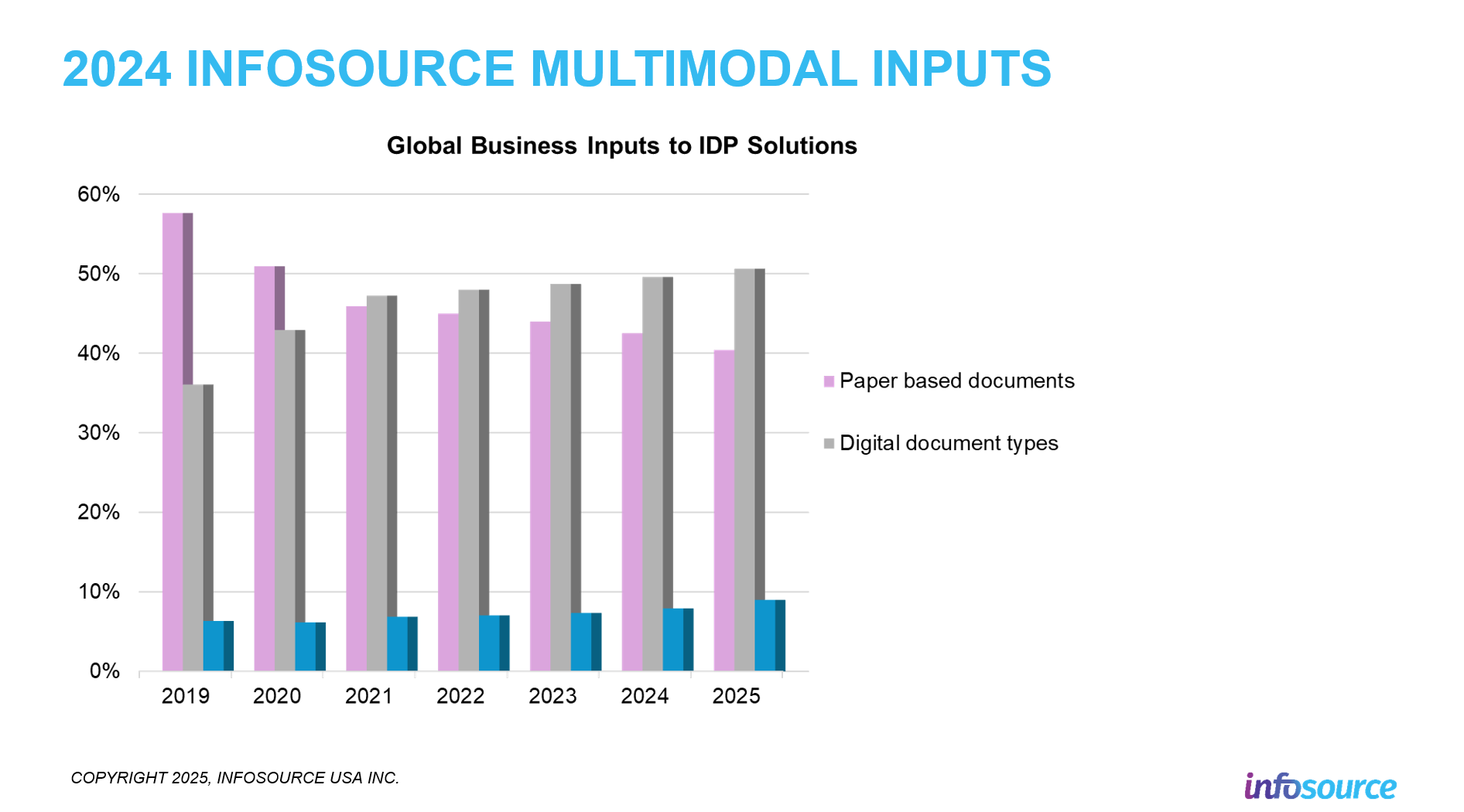
In 2025, the integration of multimodal language models will significantly impact GenAI-infused IDP solutions. These advanced models, capable of understanding and processing multiple forms of data, will enhance the capabilities of GenAI-infused IDP systems. By leveraging these models, businesses can achieve higher accuracy in data extraction and processing, regardless of the input format.
#5: GenAI is a Double-Edged Sword from a Sustainability Perspective
As we move into 2025, Intelligent Document Processing (IDP) solutions will increasingly leverage Generative AI (GenAI) technologies. GenAI offers significant benefits for the automation of business processes, supporting organisations in their efforts to digitally transform. Digital transformation itself supports circular economy initiatives. However, the training, customisation, and deployment of Large Language Models (LLMs) present major challenges related to their energy consumption.
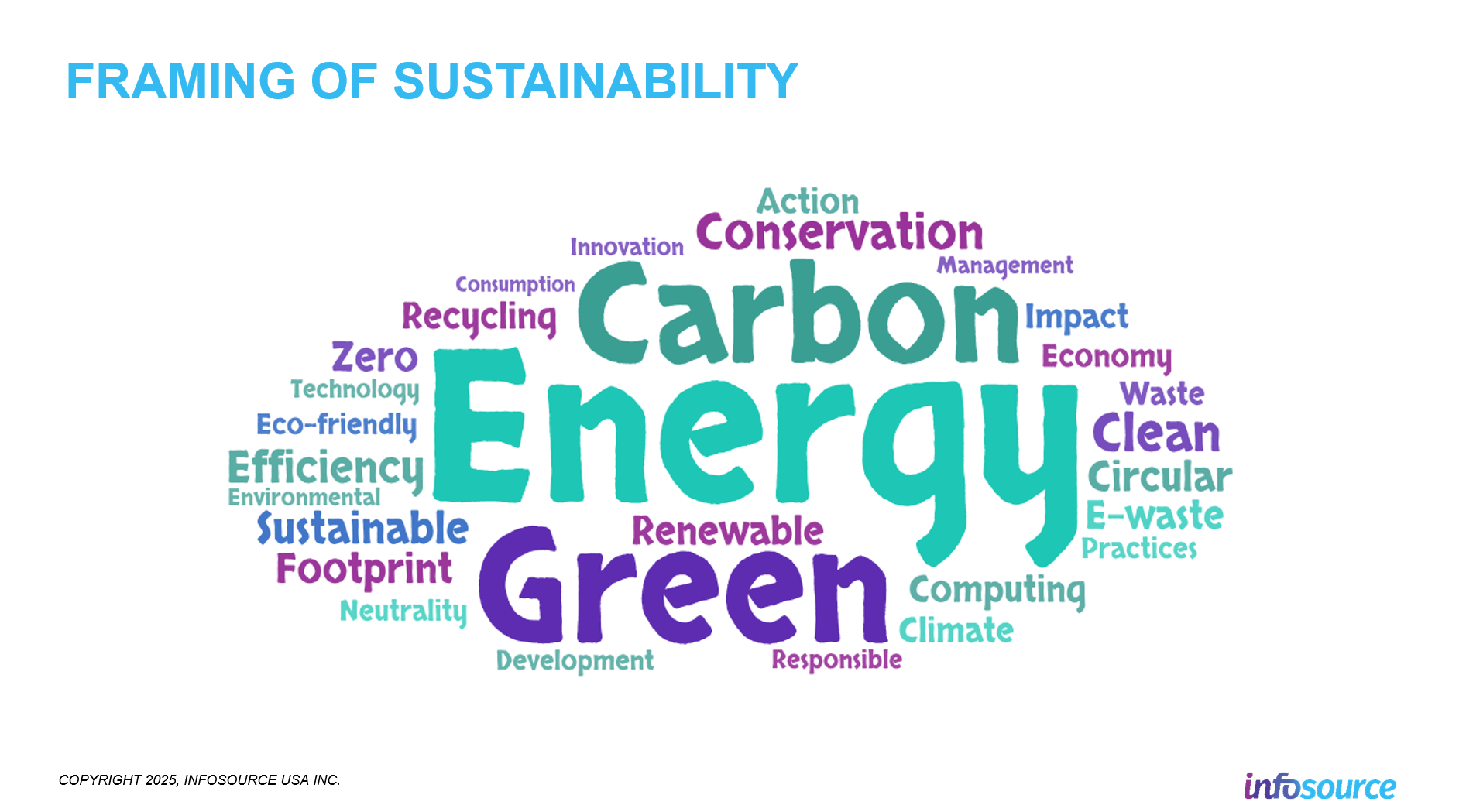
In 2025, we will see the following dynamics that will significantly impact the IDP market from a sustainability perspective:
- Growing Importance of the Circular Economy: The increasing pressure on organisations to reduce their carbon footprint is bolstered by consumer awareness and commitment to a circular economy.
- Carbon Footprint Considerations Extend to the IT Space: Carbon footprint is already a major consideration in areas like transportation, energy sources, and hardware manufacturing. As company-wide carbon footprint goals become more refined and extend to all functions, they will also encompass the IT department.
- Sustainability Considerations in Digital Transformation Projects: The reduction of physical paper documents supports carbon footprint goals, as does the shift to cloud-based information management. For a comprehensive assessment, it is key to evaluate the entire document life cycle.
- Energy Consumption and Carbon Footprint of GenAI Technology: GenAI’s energy consumption is a significant concern. Training and deploying large AI models require substantial computational power, leading to increased energy use and carbon emissions.
- Sustainable Data Centres Will Be Key: To mitigate the environmental impact of GenAI, there will be a push towards more energy-efficient data centres. Utilising renewable energy sources and advanced cooling technologies will be essential to reduce the carbon footprint of data centres that support GenAI applications.
Generative AI is a double-edged sword in the Intelligent Document Processing market. While it offers significant efficiency gains, which lead to environmental benefits, its energy consumption and carbon footprint pose sustainability challenges. As we navigate 2025, organisations will need to carefully balance these impacts.
I had the privilege to present on this topic at the 2024 Global AIIM conference and wrote an article on The Environmental Impact of Information Management.
#6: Strongest Growth Expected in the Finance Industry
As we look ahead to 2025, the finance sector is set to experience the strongest increase in demand for Intelligent Document Processing (IDP) solutions this year. The unique characteristics of this vertical have made it an early adopter of Intelligent Capture and IDP solutions, resulting in a relatively high maturity in automation and the deployment of AI-based technologies.
This presents a strong basis for future growth with the following drivers:
- Competitive Pressure and Market Dynamics: The banking and insurance sectors are facing increasing competitive pressure from newer players like neo-banks and InsurTech service providers, as well as embedded financial services. To stay competitive, traditional vendors in the vertical are looking for advanced IDP solutions to differentiate themselves and improve operational efficiency.
- Digital Transformation and Customer Experience: Banks and insurance carriers are under strong pressure to digitally transform and meet the demand for high customer experience. IDP solutions play a crucial role in streamlining these processes, reducing wait times, and improving overall customer satisfaction.
- Integration with Advanced Technologies: The finance sector has been at the forefront of embracing advanced technologies like artificial intelligence (AI) and machine learning (ML) in the past few years. These technologies enable more accurate data extraction and analysis, supporting better decision-making and risk management within banks.
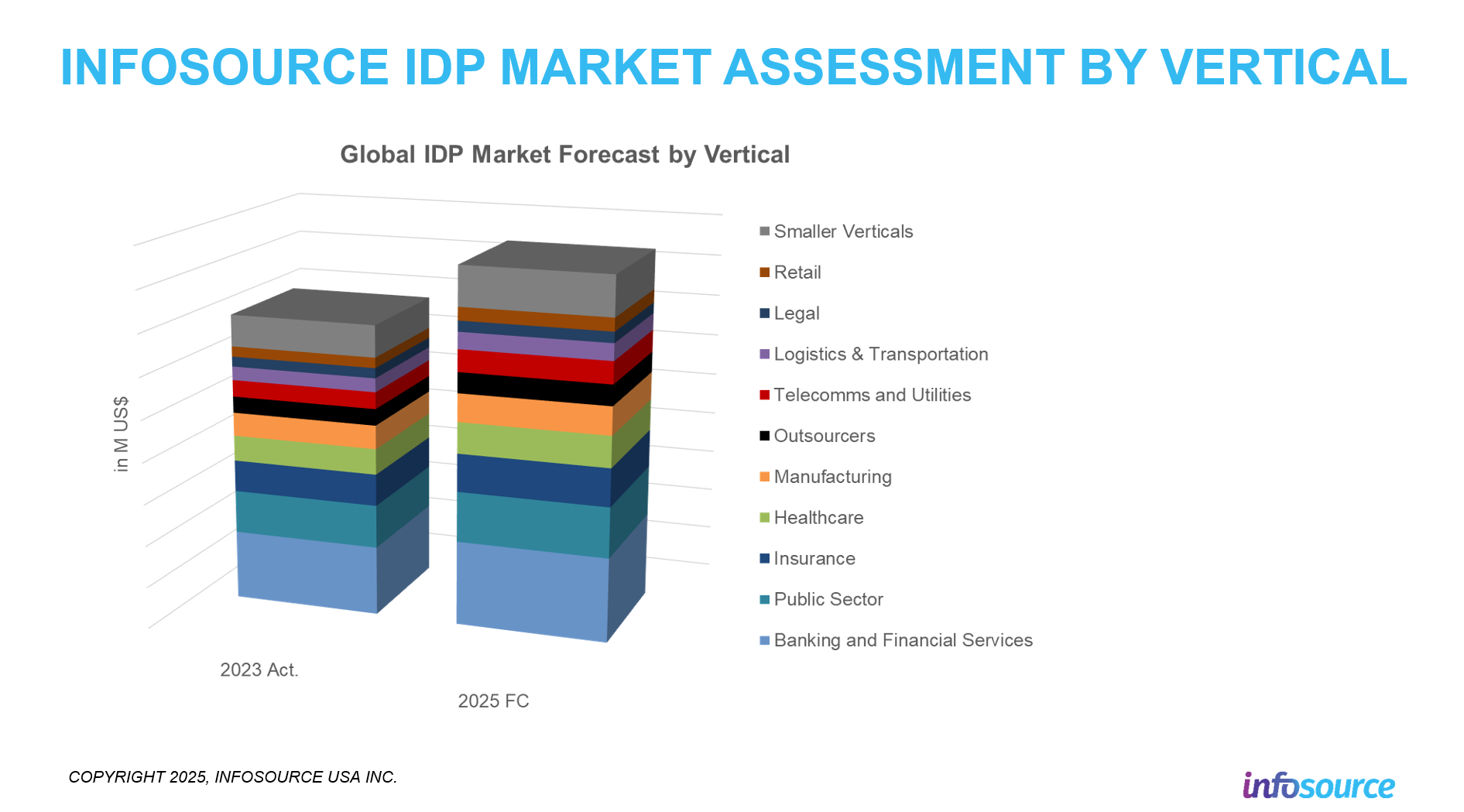
The finance sector is expected to be at the forefront of embracing Generative AI (GenAI) technologies. Banks, in particular, are already familiar with AI and machine learning, having integrated these technologies to enhance decision-making, risk management, and customer service. The expertise and proven results of AI-based solutions make banks well-positioned to leverage GenAI for even more advanced document processing capabilities. This will further streamline operations, improve accuracy, and provide personalised customer experiences, solidifying their competitive edge in the market.
I recently published my annual in-depth assessment of the IDP market by industry sector. Some highlights can be found in this article: Infosource Global IDP Vertical Market Analysis 2023-2024 Update – Info-source.com
#7: GenAI Accelerates Business Process Automation
As we progress through 2025, the influence of Generative AI (GenAI) on Intelligent Document Processing (IDP) is becoming increasingly pronounced. GenAI will enhance the input ingestion element of IDP solutions by offering advanced classification and extraction results. However, the even greater value will emerge in advancing process automation steps.
Key developments in this area include:
- Real-time Processing: GenAI’s capability to process data and make decisions instantaneously is a game-changer. This real-time processing allows for immediate adaptation to changes and unforeseen events, ensuring that business processes remain robust and effective. It requires the tight integration of IDP solutions with automation technologies like Robotic Process Automation (RPA) and Business Process Automation (BPA) as the underlying foundation.
- Agentic Process Automation: The deployment of AI agents is enabling the automation of process steps in a dynamic, self-regulated way. These agents are designed to operate autonomously within defined boundaries, guided by supervising agents and potentially Human-in-the-Loop (HITL) steps. This significantly reduces the need for human intervention, enhancing operational efficiency.
- Integration with Line-of-Business (LOB) Applications: The seamless integration of GenAI with LOB applications, as well as enterprise systems such as ERP and CRM, is crucial to enable end-to-end automation. This integration facilitates the elimination of data silos, providing a comprehensive view of business operations and improving decision-making processes.
My vision for the IDP market is to enable the autonomous end-to-end automation of mission-critical business processes. The maturity model I developed a couple of years ago conveys my view of the evolution of the Capture and IDP market.
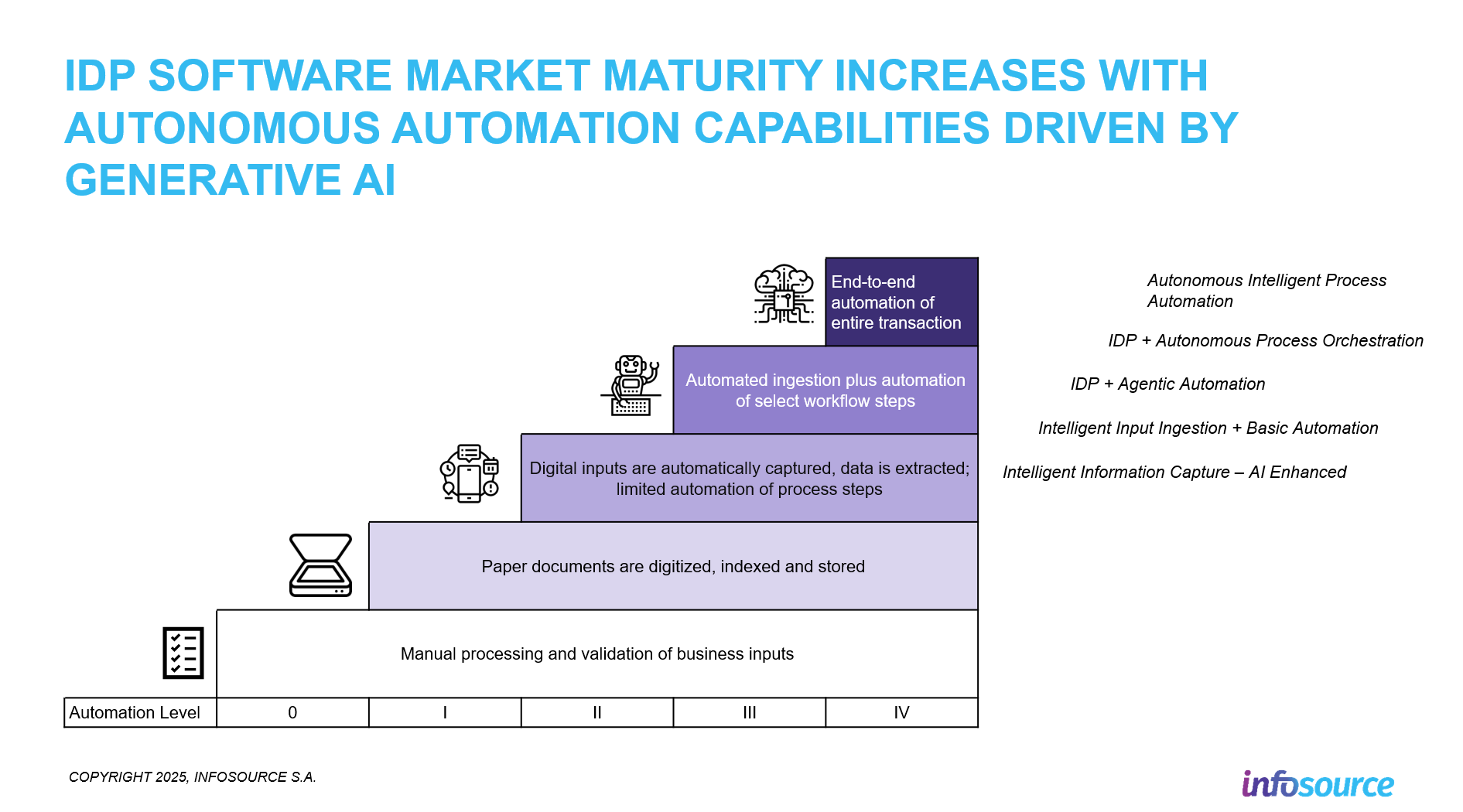
While the advent of Agentic AI solutions will play an important role this year, it is just an interim, yet significant milestone towards this goal. Autonomous end-to-end automation requires GenAI-based process orchestration with advanced reasoning, domain expertise, and tight integration in the organisation’s infrastructure.
#8: SMBs Present a Hidden Opportunity
While large enterprises have traditionally dominated the demand for Capture and Intelligent Document Processing (IDP) solutions, small and medium-sized businesses (SMBs) are going to outperform their growth rates. They will see particular benefits from the influence of Generative AI (GenAI).
SMBs will benefit in particular from the following advantages:
- Increased Operational Efficiency and Productivity: Mid-sized companies often struggle with limited resources and are particularly impacted by the shortage of knowledge workers. Advanced IDP solutions can alleviate these challenges by automating manual processes, thereby enhancing their adaptability to fluctuating business volumes and requirements.
- Enhanced Competitiveness: A significant challenge in the SMB sector is the need to swiftly adapt their positioning and offerings to meet evolving market demands. IDP solutions, augmented by GenAI technologies, empower SMBs to deliver superior customer experiences, thereby boosting their competitiveness.
- Openness to Innovation: SMBs are renowned for their flexibility and willingness to embrace new technologies. This characteristic positions them favourably to adopt GenAI-based IDP solutions as they become more accessible and affordable.
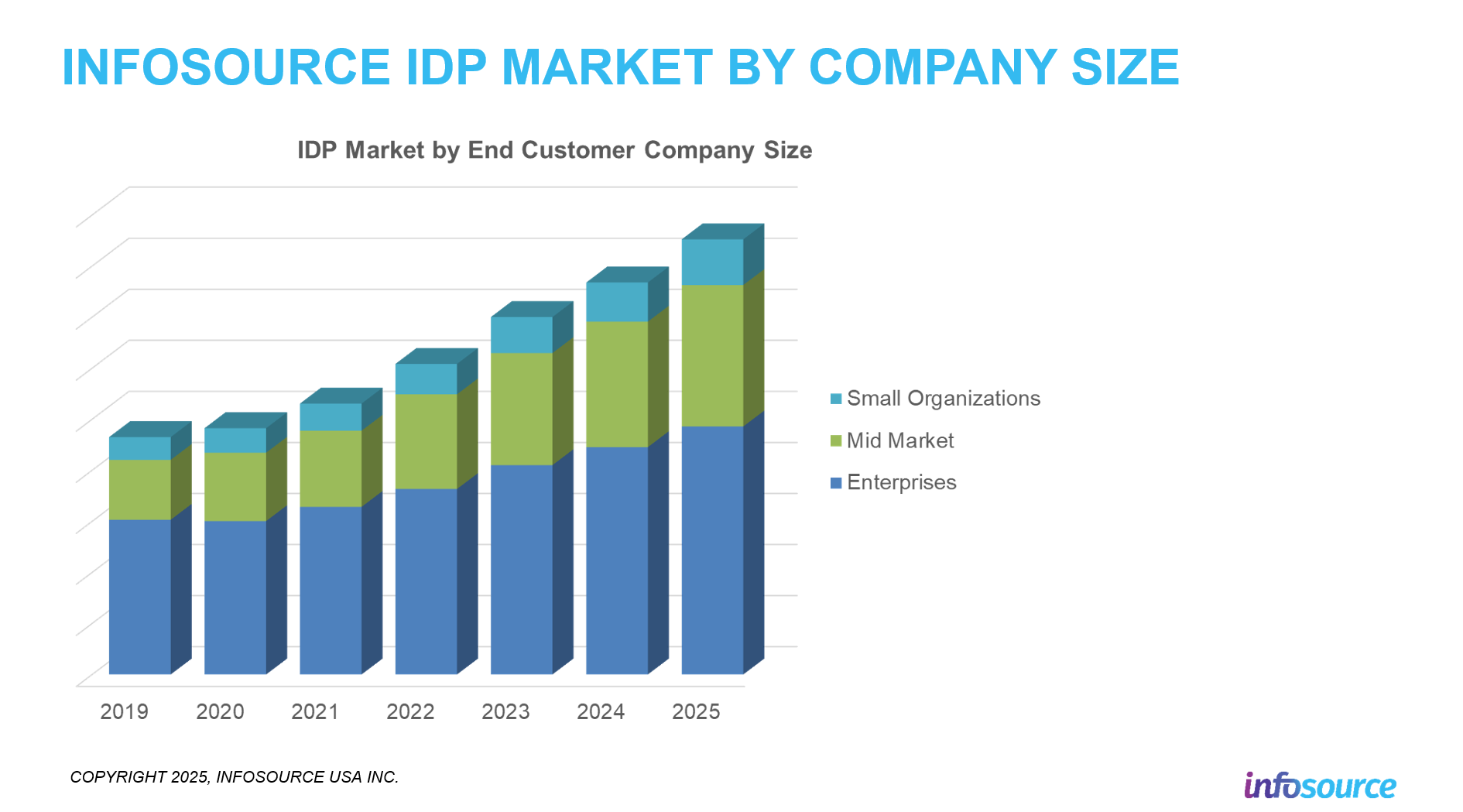
The SMB market is set to play a crucial role in the demand for IDP solutions in the coming years. The advantages of Generative AI will offer particular benefits for SMBs that allow them to overcome traditional barriers and unlock new business opportunities.
#9: GenAI Creates New IDP Use Case: Knowledge Base
Generative AI (GenAI) offers significant benefits for Intelligent Document Processing (IDP) solutions by enhancing the ingestion of business inputs and automating subsequent process steps. Additionally, IDP solutions play a crucial role in establishing knowledge bases that provide training data, contextual understanding, consistency, and accuracy for GenAI-based deployment.
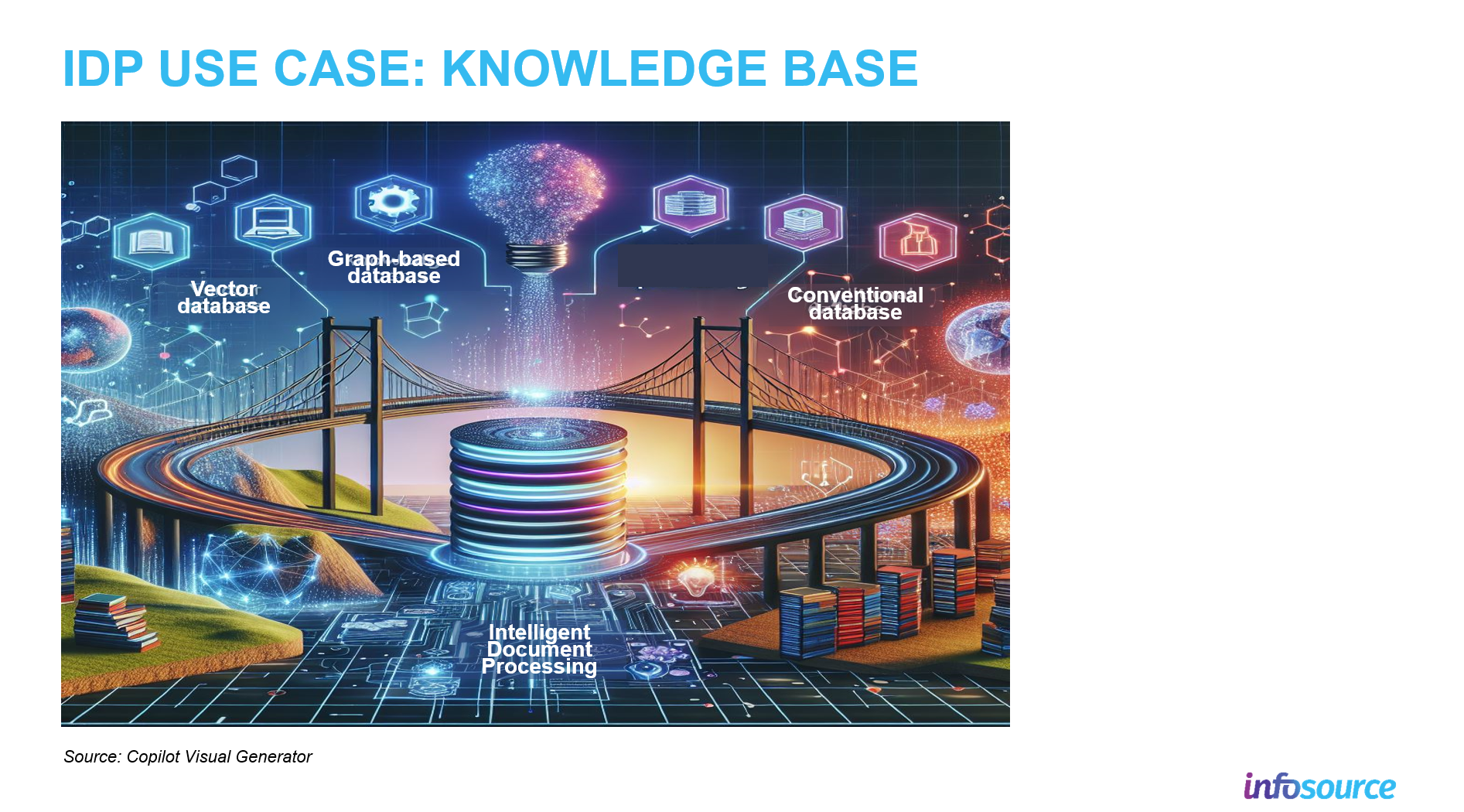
Key Characteristics of This New Use Case:
- Importance of Knowledge Bases for GenAI Applications: The initial deployments of GenAI technologies in business process automation have highlighted the critical role of data quality. Reliable knowledge bases are essential for training or fine-tuning GenAI models and continuous learning, as the quality of input data directly impacts the accuracy of the results.
- IDP Capabilities for Creating a Knowledge Base: IDP solutions support organisations in converting unstructured and semi-structured documents into high-quality, structured data. These solutions can process and normalise inputs from various sources, map them to predefined ontologies, and semantically enrich them, which is crucial for creating a robust knowledge base.
- Support for Different Types of Knowledge Bases: IDP solutions can support various types of databases, including vector, graph-based, and conventional databases. The creation of vector databases is particularly prominent due to their ability to handle unstructured elements effectively.
In this emerging use case of knowledge base development, IDP solutions act as a bridge between raw, unstructured data and advanced AI systems, enabling businesses to ground their GenAI applications in high-quality, contextual data.
#10: GenAI Expertise to Determine Vendor Success
In the ever-evolving Capture and Intelligent Document Processing (IDP) market, AI has become a fundamental component. All vendors classified as Advanced Capture or IDP vendors are leveraging AI in some form. Proprietary models have been in use for several years, augmenting traditional imaging-based Capture solutions. AI-native vendors have entered the market in recent years, introducing advanced AI technologies such as Convolutional Neural Networks (CNNs) and deep learning capabilities. Over the past two years, Generative AI (GenAI) technology has offered a significant productivity boost for the IDP market.
Vendors with deep expertise in AI technologies have been at the forefront of embracing GenAI. They have quickly started experimenting with various Large Language Models (LLMs) to explore their value in classification, summarisation, contextual entity extraction, and determining the next best action. We have seen an increasing number of IDP vendors announce enhanced versions of their platforms or specific use case offerings in recent months. Additionally, many IDP vendors are focusing on customising General Language Models to develop smaller, specialised Language Models and establish Retrieval Augmented Generation approaches.
In my quantitative assessment of the IDP market, I have witnessed the strongest growth among vendors who are at the forefront of intelligent automation. These vendors enhance input management through AI technologies and integrate their IDP solutions into end-to-end process automation efforts. I look forward to quantifying this in the coming months with the latest vendor data.
In the meantime, my colleague @Ralph Gammon will establish his annual update of the IDP Vendor Matrix. In the 2024 vendor matrix, published at the beginning of 2024, he noted that LLMs and Generative AI were just beginning to make their mark in our industry. He also observed in last year’s vendor assessment that the ability to effectively leverage Generative AI and LLMs for Capture, IDP, and related applications will empower the most successful vendors going forward.
Here is the matrix visual of the 2024 Global Vendor Matrix and a link to the press release: INFOSOURCE RELEASES REPORT ON LEADING SW VENDORS – Info-source.com
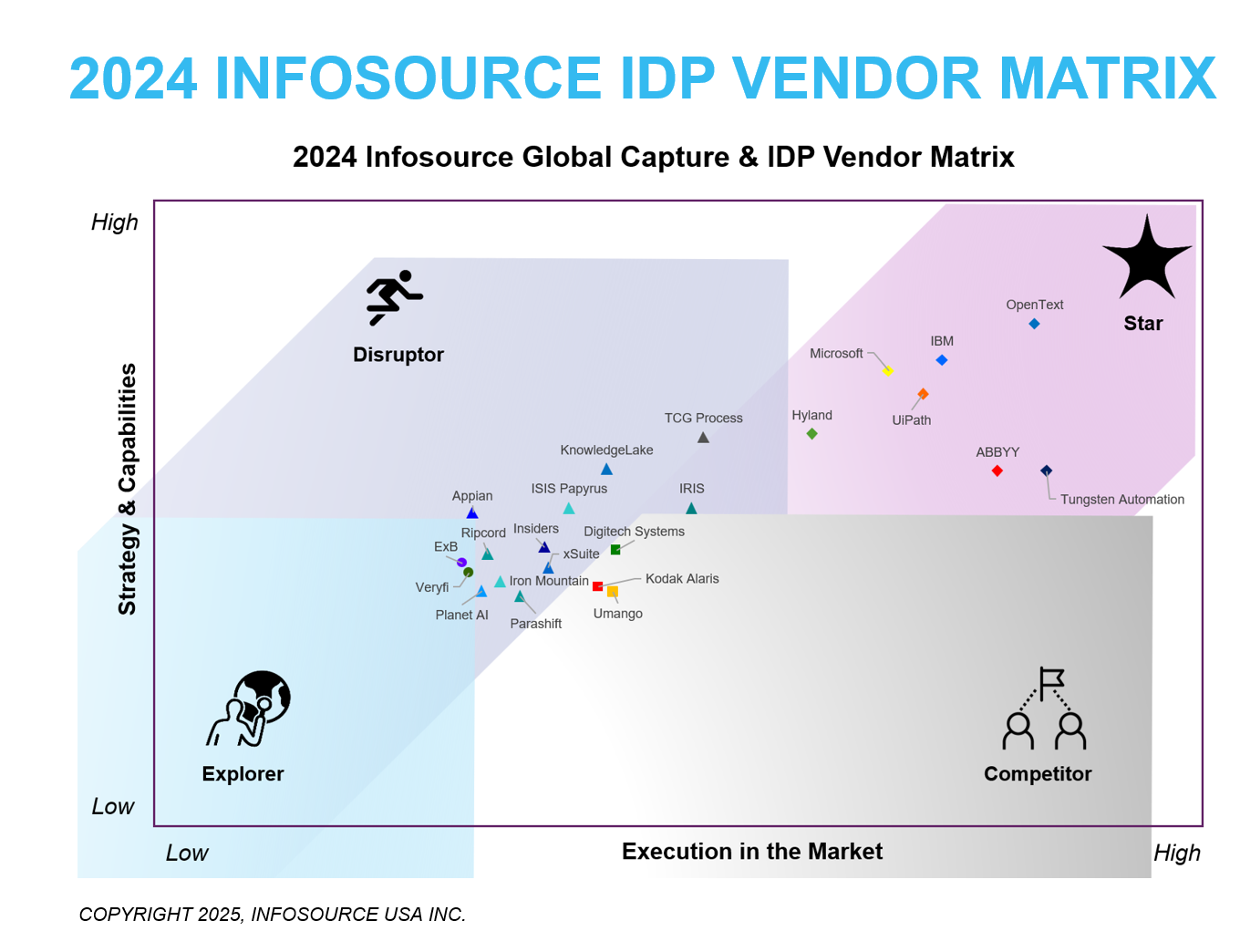
Recognising the significant advancements of GenAI technologies in the IDP market, he is attributing greater weight to GenAI-based capabilities in the 2025 matrix criteria.
By understanding and embracing the potential of Generative AI, IDP vendors can position themselves at the forefront of innovation, ensuring their success in a rapidly evolving market.